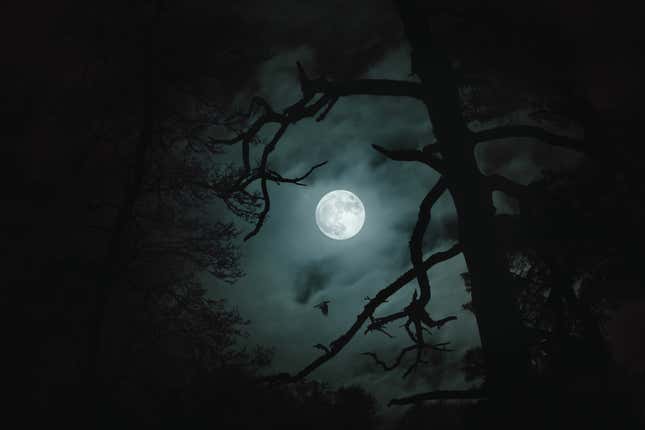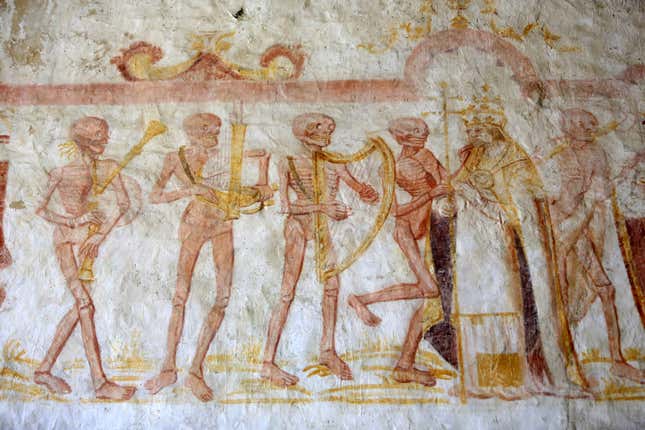
I heard there was a scary chord...
Let’s face it. When it comes to creating a creepy Halloween atmosphere, the modern pop canon doesn’t have much to work with. Fortunately, ye olde Europeans liked their music a lot more chilling than “Thriller.”
During the 19th century, composers like Franz Liszt and Richard Wagner cracked the code of creepiness. The sonic dread they pioneered involved two key ingredients that horror movies and metal bands still use today: a forbidden sequence of notes known as “Satan in music,” and a spooky little ditty that Gregorian monks sang about the apocalypse.
♫ Cue unsettling chord ♫
Brief history

A taboo tune
In the Middle Ages, most Western music was written in praise of God, and was therefore supposed to sound pleasant. For composers, that wasn’t a huge constraint. Take a C major scale—i.e. just the white keys on the piano—plunk out any two-note combination, and you’ll find a holy ghost-grade harmony.
Except one.
Played in sequence or together, the interval between the notes F and B clash in a way that feels twitchy, unnatural, and foreboding. (If you don’t have a keyboard handy, think of the first two notes of Jimi Hendrix’s “Purple Haze” or Metallica’s “Enter Sandman”—or American police sirens.) It’s this interval that folks in the dark ages and the Renaissance called diabolus in musica—“Satan in music.” Modern music theorists know it as the tritone (as well as a diminished fifth, or an augmented fourth), though it’s also called the devil’s interval or the devil’s triad.
This demonic combo was taboo in medieval times, though there’s no historical evidence for the popular claim that it was banned outright. But it was saved for the gravest of musical circumstances, like portraying the devil or the crucifixion.
Explain it like I’m 5!
Why is the tritone so freaky?
“The reason it’s unsettling is that it’s ambiguous, unresolved,” Gerald Moshell, a former music professor at Trinity College in Connecticut, told NPR. “You don’t know where it’ll go, but it can’t stop where it is.” If you change one of the two notes just slightly, the dissonance turns to harmony. What’s really happening when we hear dissonance has to do with the relationship between frequencies—the two pitches of the devil’s interval create a much more complicated ratio of frequencies than other intervals, and are therefore much harder for the human ear to reconcile. (For instance, using our C major example, the frequency ratio of C to G is 3:2, while for the tritone, it’s 45:32, according to Classical FM.)
Pop quiz

Which popular TV sitcom begins its opening theme song with a tritone?
A. The Simpsons
B. The Big Bang Theory
C. Will & Grace
D. How I Met Your Mother
Listen, if you’re spooked by the way your memory is failing you, don’t fret — the answer is at the bottom.
Pop pioneers
How the devil’s interval went mainstream
Even during the Baroque and Classical eras, as the Catholic Church’s influence over culture faded, composers continued to eschew the devil’s interval. In the odd passages where tritones appeared, their use was technical: to create—and quickly resolve—tension.
Then suddenly, at the dawn of the Romantic era of classical music, there it is, in Act 2 of Beethoven’s 1805 opera Fidelio. As the scene opens in a dungeon, the kettle drums rumble menacingly—tuned in the devil’s interval. (They appear at around 1:20 in this recording.) Something akin to obsession followed, as composers used tritones to probe the darker corners of nature and humanity.
Catchy ditties
Enter the day of wrath
Romantic composers also got a lot of doom out of another bit of medieval Roman Catholic music: the haunting 13th-century Gregorian chant Dies Irae, or “Day of Wrath.” Creepmeister extraordinaire Hector Berlioz, a French composer, gets credit for the blood-curdling breakthrough in his freaky 1830 Symphonie Fantastique.
It’s about an artist who, believing himself rejected by a woman he’s stalking, tries to overdose on opium. Instead, he hallucinates that he kills the woman, is beheaded, and witnesses his funeral devolve into a witches’ sabbath. The Dies Irae comes in during the final movement, in a fugue with dancing witches, a bubbling cauldron, and a diabolical orgy (in this recording, at about 3:25).
But the work was not entirely fantastique. Berlioz himself was a stalker, and some historians think he composed it while high on opium. He also hatched a bumbling—and thankfully abortive—plan to murder his former fiancée.
How we 😱 now

Tritones of today
Whether in a Jameson’s whiskey ad or in the creepiest-ever episode of Buffy the Vampire Slayer, you’ve almost certainly heard “Danse macabre” before. The Dies Irae is also ubiquitous as a go-to terror trope. So obsessed with the melody was Stanley Kubrick that he supposedly demanded its use for the opening music of The Shining. It also figures into horror classics like The Exorcist and Poltergeist.
Among heavy metal bands, the devil’s interval has long enjoyed something approaching cult status. Slayer, for instance, named its 1998 album Diabolus in Musica. Perhaps the most famous paean to its unholy eeriness is the opening of Black Sabbath’s “Black Sabbath.” But other genres have broadened its appeal. In the first notes of the song “Maria,” from West Side Story, composer Leonard Bernstein used a tritone to create a weird tension that then resolves. Thanks to the tritone’s unique ambiguity, it’s also ubiquitous in jazz chords.
Its wider popularity these days probably has something to do with the fact that Death and the devil have lost some of their power to terrify over the last 150 years. But in the music written to explore those fears, that power endures.
Poll

What’s your favorite use of the devil’s interval?
- Keeping it real with “Danse Macabre”
- Keeping it real with G. Love’s “Cold Beverage”
- I’m more of a “Maria” type of person
Give us something to jive to — let us know your answer!
💬 Let’s talk!
In last week’s poll on Target, 66% of you can’t walk out of the store without spending $100, while 30% of you forgot in-person shopping was a thing. The rest are Walmart loyals.
🐤 X this!
🤔 What did you think of today’s email?
💡 What should we obsess over next?
Today’s email is one from the archives. It was written by Gwynn Guilford, edited by Jessanne Collins, and produced by Luiz Romero. Updates were made by Morgan Haefner.
The correct answer to the pop quiz is A., The Simpsons.



